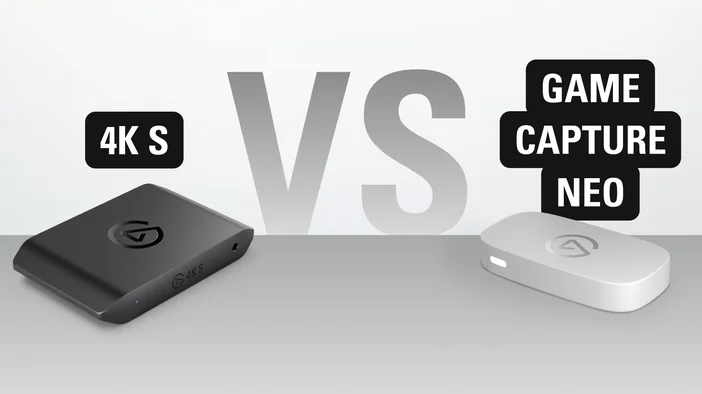Whether you're just starting out or leveling up your content creation, Elgato Game Capture 4K S and Game Capture Neo both offer streamlined ways to record or stream your gameplay in stunning quality. But they’re built with different creators in mind. Let’s take a look at what sets them apart.

At a glance
| 4K S | Game Capture Neo | |
|---|---|---|
| MSRP | $159.99 USD | $129.99 USD |
| Perfect for | Switch 2, PlayStation 5, Xbox Series X | Switch, PlayStation 5, Xbox Series S |
| Capture resolution (Max) | 4K60 | 1080p60 |
| 1440p Capture (max) | 1440p120 | N/A |
| Passthrough resolution | Up to 4K60 / 1440p120 | Up to 4K60 / 1440p60 |
| HDR Passthrough | Up to 4K60 | Up to 4K60 |
| HDR capture | Up to 1080p60 | N/A |
| Variable Refresh Rate Passthrough | Yes | N/A |
| HDMI (Input & output) | HDMI 2.0 | HDMI 2.0 |
| PC interface | USB-C 3.0 (5Gbps) | USB-C 3.0 (5Gbps) |
| Analog Audio In | 3.5mm | N/A |
| Software | Elgato Studio, OBS, etc. | Elgato Studio, 4KCU, OBS, etc. |
High Frame Rates & Performance Headroom
Both 4K S and Neo support 4K60 HDR passthrough, so you can play your games at full resolution without sacrificing visual fidelity. However, only 4K S captures 4K60 gameplay, and it goes a step further with support for Variable Refresh Rate (VRR). That means smoother visuals and reduced screen tearing when gaming on supported displays.
Neo is designed for simplicity. It lets you play in 4K60 HDR while capturing a smooth, no-frills 1080p60 recording. It’s perfect for creators who want great-looking content without the heavier file sizes or higher system demands of 4K capture.
On the other hand, 4K S gives you 4K60 capture. Ideal for preserving every detail in your footage, this is the card you want if you're showcasing next-gen titles or publishing high-res content to YouTube and beyond.
Software & Workflow
4K S goes beyond resolution as it supports 1440p120 and 1080p240 capture. That means ultra-smooth slow-motion replays, high-FPS content, and full fidelity when recording fast-paced gameplay.
Neo, meanwhile, sticks to 1080p60 capture only, offering a simplified experience that’s ideal for plug-and-play workflows and creators who don’t need high frame rate recording.
If your content benefits from crisp detail and fluid motion, 4K S gives you the performance headroom to grow into.
Both devices work with Elgato Studio, offering easy setup, intuitive visuals, and native Stream Deck integration. You’ll get a clear view of your signal chain, real-time diagnostics, and bold indicators that make recording a no-guesswork process.
Whether you’re working with Neo or 4K S, Elgato Studio puts all your essential controls in one place, with customizable actions ready to launch from Stream Deck.
Platform Compatibility
Both Neo and 4K S support Windows, macOS, and iPadOS, with plug-and-play functionality over USB-C. They’re equally ready for PS5, Xbox, Switch 2, Steam Deck, PC, and more.
The difference lies in what you want to do with that signal once it's connected.
Price Point — Simplicity or Scalability
Game Capture Neo is Elgato’s most accessible capture card, priced at $129.99 to lower the barrier to entry. It’s perfect for new creators who want to start capturing console gameplay without diving into complex workflows.
4K S, while still affordably priced at $159.99, offers significantly more: full 4K60 capture, high frame rate support, and a longer runway for growth as your content evolves.
4K Capture — Playback vs. Recording
If you're just getting started and want something lightweight, reliable, and easy to use, Game Capture Neo is a fantastic first step. You’ll get smooth Full HD capture, simple setup, and the ability to play in 4K60 HDR—all without overthinking it.
But if you’re ready to push into higher resolutions, frame rates, and post-production quality, Game Capture 4K S offers far more headroom, while still keeping your workflow simple and accessible.
Both cards are powerful. The difference lies in how far you want to take your content.
PRODUCTS IN ARTICLE